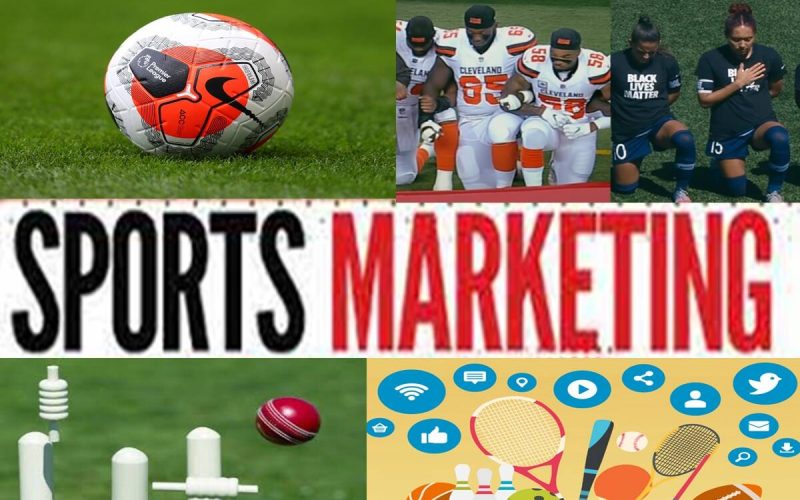Few things in the world are as popular as sports. According to the National Football Foundation, 49,670,895 people attended an NCAA football game in 2011, while Nielsen reported that over 110 million people watched the 2012 Superbowl. Sports catch the attention of more people than nearly any other type of event, from die-hard fans to casual watchers.
Marketers recognize the popularity of sports and have used them as a focal point of marketing initiatives for decades. As the scale and popularity of national sports have risen, so has the field of sports marketing. According to CNBC, Budweiser has spent about 240 million dollars on Super Bowl advertisements alone in the last ten years. Sports will continue to be a prime event for delivering advertising messages as long as they continue to thrill hundreds of millions of people. Let’s learn more about sports marketing and also see some examples of the strategies in this post.
What Is Sports Marketing?
Sports marketing is a marketing approach that uses an athlete or a team to promote sporting events, equipment, or products and services.
Using an athlete or a team serves a single purpose. A player or a team serves as an influencer, having a direct impact on the audience.
Nike, for example, has teamed up with Mike Jordan, a well-known basketball star, to create a new line of sneakers known as Air Jordans.
Air Jordans have been introduced. Nike started a shoe frenzy and also formed a clique that began collecting sneakers. This group gave birth to a new group known as Sneakerheads, which gave birth to an entirely new market for sneakers.
An athlete’s agent often guarantees that they endorse specific companies and products while also preserving their professional job. In fact, when certain conditions are taken into account, such as the high level of fame experienced by male cricketers in India, it is part of a professional athlete’s job to promote brands.
Athletes and teams may endorse a specific product or simply a brand image. Sportspeople can promote anything from a charitable cause to a sportswear business. Sportsmen and sports teams are immensely popular among a broad audience, and by capitalizing on this popularity, both producers of the endorsed goods and services and the athletes and teams themselves can profit.
By purchasing things sponsored by sports, the consumer becomes a part of a process in which the producer funds athletes, teams, and events.
Sports marketing methods adhere to the four “Ps” of general marketing. They are as follows: Product, Price, Promotion, and Place. Because sports are a service, sports marketing includes four more “Ps.” Planning, Packaging, Positioning, and Perception are the four components. This is referred to as the “Sports marketing mix.”
Types of Sports Marketing
#1. Marketing of Sports
Sports marketing is the promotion of sports, sporting events, sporting associations, and sporting teams. This type of promotion is directly related to sports. It is defined as creating or designing a “live” activity with a specific theme.
The goal is to display or market events, teams, and associations. The Olympics and the Super Bowl are two examples of this concept. The NFL, which organizes the Superbowl, aims to promote both the Superbowl and American football in general, as well as the various competing teams. As a result, this industry is concerned with promoting sports to the general population.
#2. Marketing through Sports
Sports marketing is concerned with the promotion of various commodities, services, or causes by capitalizing on the popularity of sports and sportsmen. This is the industry that deals with sportsmen and sports teams promoting various companies, as well as sponsors using sporting events to sell their products to viewers.
This is where several advertisement platforms are used with a specific focus on promoting a product. This type of marketing may fall under the purview of sports associations or sports clubs. In addition to sponsorship and endorsement, there is the selling of branded items, events where athletes connect with their fans, and so on.
#3. Grassroots Sports Marketing
Sports marketing at the grassroots level is focused on promoting sports to the general public. This is done to increase the appeal of a sport as exercise rather than amusement. The goal is to encourage athletic participation.
This is social marketing since it benefits the whole people. It is typically carried out by sports associations that want to raise interest in their sport, as well as governmental authorities and philanthropic organizations that want to improve young involvement and minimize healthcare costs by promoting activity.
Why Is Sports Marketing Important?
Without marketing, the sporting business would not be as successful as it is now. The sporting industry is still a business, despite the camaraderie, wonderful games, and renowned athletes. Ticket sales and sponsorships enable teams and clubs to stage exciting contests. Because of the devotion of its followers, sports clubs have survived. But, now that things have changed, sports marketing is more important than ever. The competition is more intense than ever. And players who wish to advance should understand the significance of sports marketing to the industry’s success.
#1. Sports enthusiasts have a high level of loyalty.
Loyal customers are six times more likely to think better of your companies, six times more likely to behave better toward your companies, six times more likely to buy more of your products, six times more likely to reject competitor offers, and six times more likely to suggest your brand.
The devotion that fans feel for their favorite team and athletes. You’ve probably felt this connection firsthand if you have a favorite sport, club, team, or professional sports athlete. There is a connection when you see someone wearing a jersey that represents your people, whoever they may be. There is a bond.
This kind of loyalty is uncommon in many sectors. It’s unlikely you’ve ever seen someone sipping tea and saying, “Say, that’s my favorite brand, too.” “I particularly enjoy the undertones in this season’s collection,” yet this happens frequently among sports fans.
#2. Athlete influencers can help sports brands capitalize on this loyalty.
Not surprisingly, fan loyalty extends to anything linked with a fan’s favorite club, team, or athlete, as well as, of course, ticket sales. When people witness these athletes wearing specific luxury timepieces, it raises the brands’ awareness and helps them establish themselves as world-class leaders. Obviously, not everyone can afford a Rolex or a Richard Mille, but the objective of having the timepieces on the wrists of professional sportsmen is to demonstrate the brand’s exclusivity. Nike, on the other hand, frequently collaborates with everyday athletes.
The brand enjoys showcasing stars that originated from humble beginnings and climbed to prominence through talent and effort. Fans of players wearing Nike brand attire, as a result, link the brand with victory, and they begin wearing it because it makes them feel like they’re part of the professional athlete’s squad. They, too, are victorious.
Fans want to look like the athletes they admire, whether it’s through the attire they wear, the phones they use, the shoes they run in, or the food they consume. Sports groups and companies are well aware of this. Simply said, engaging with athlete influencers may help you reach a variety of goals, such as improving loyalty, raising brand exposure, increasing website traffic, expanding into new markets, or appealing to a specific sports marketing demographic. These factors naturally lead to increased sales and marketing revenues.
Sporting Marketing Uses
Sports marketing is particularly valuable in a variety of ways, most notably in terms of how the popularity of sports can be exploited by the business industry to promote sports in return.
#1. Brand Recognition
Sporting events are extensively and repeatedly watched by a large number of people. Companies may ensure that their products are continually and persistently exposed to audiences by advertising their products in the stadium and during event telecasts. Organizations may utilize the trust of their fans by having prominent athletes and sports teams promote their products. Essentially, if a consumer’s favorite athlete or team endorses a brand, the consumer trusts the brand as a result of the endorsement. Many brands become inextricably associated with a specific event, athlete, or team, and the public associates the two and trusts the brand as a result.
#2. Promoting new products:
Organizations can promote a new product more simply if an athlete or team endorses it. While most individuals would be hesitant to put their faith in a new product or service that they have no firsthand knowledge of, having sports superstars advocate the product leverages the celebrity’s status to increase public trust and interest in the product. This is a marketing strategy that is particularly effective for sportswear and healthy food. A testimonial from a sportsperson adds credibility to these products.
#3. Raising viewership and revenue:
Promoting sporting events and associations, as well as teams, via a number of platforms such as print media, television, social media, and billboards guarantees that those events, associations, and teams receive widespread attention. Revenue will rise in tandem with interest when people watch the events in person and at home and elect to support those teams and sports groups. Sports fans, as well as athletes, are needed in the sports sector. The industry would incur financial losses if there was no outside interest in sports. Promoting sports causes individuals who are not players to become interested in the sport, which benefits both the industry and the sport itself.
#4. Public service
Sports marketing can be used to meet the needs of the general audience. Athletes support philanthropic causes and, due to their notoriety, can readily raise aid for those in need. The government can promote sports to at-risk kids and, by subsidizing their involvement, increase engagement while also providing the youth with an economic source. Another application of sports marketing is to promote sports in order to raise public awareness of personal health. The general public is encouraged to participate in sports and, as a result, to live an active lifestyle.
Sports Marketing’s Impact on Companies and Organizations.
Sports would not have such a broad impact on the world today if it were not for marketing. Many sporting events are heavily reliant on marketing. Without anyone marketing these clubs or activities, how can anyone support their favorite football team or attend games?
Without marketing, it would be hard for sports to get large crowds to attend a game. What changes have occurred in sports marketing over time? Sports marketing is not a new concept. It has been going on for over a century, ever since sports became a career.
Consider commercials broadcasted on the radio, in newspapers, and, later, on television. With the growth of technology, sports marketing agencies now have access to a plethora of new platforms. The internet and social media are examples of this.
One example of sports marketing is how football clubs have embraced social media as a valuable tool for brand promotion. They’ve taken their marketing online on social media, from drawing new fans to promoting future matches and executing campaigns.
The Benefits of Sporting Marketing
Athletes, teams, and associations, as well as companies who fund and promote sports, benefit from sports marketing.
#1. Advantages for athletes
Athletes, teams, and associations benefit directly from endorsement arrangements. Being the face of a brand makes it more appealing to individuals who are unfamiliar with sports. This can lead to said people becoming interested in sports for the purpose of this athlete or team, increasing money from ticket sales and the like for the athlete or team. Sports marketing increases interest in a sport in general, which benefits everyone involved with that sport. They also gain media rights as a result of promoting sports.
#2. Benefits for sponsors
Business groups gain from sponsoring sporting teams and events since it generates cash for them. In addition, they might use the event or team to promote their business in exchange. Sports fans or fans of a specific club will notice the endorsement and get interested in the merchandise. Using a celebrity athlete’s endorsement is a sure approach to improve sales and profit. Sponsors can promote important events and link themselves with the event by engaging in arrangements with sports associations, which helps them in the long run.
#3. Advantages for viewers
Viewers benefit from sports marketing because they become more aware of different sports and sporting events. Through promotional events, sports marketing allows fans to interact with their favorite sportsmen. It also aims to increase spectator participation in sports. If marketing methods are used appropriately, fans can become athletes themselves. Sports marketing satisfies customer wants through trade mechanisms.
#4. Benefits for venue location:
Cities and countries that host major sporting events gain immensely from sports marketing. The event, such as the Olympics, is frequently publicized with a focus on the country or city that is hosting it. Taxation provides direct money to the city or country. A large sporting event, such as the World Cup, also results in an increase in tourism. Fans of the sport or a certain team or athlete frequently go to this location to witness the event in person. If the event is publicized, it will generate cash from the tourism business.
Sport Marketing’s Drawbacks
Sports marketing has certain drawbacks as well.
Excessive power in the hands of businesses, brand oversaturation, and so on are examples of the drawbacks of sports marketing.
#1. Lack of originality
The sports sector is flooded with brands. During the course of watching a sporting event, viewers are subjected to a significant number of advertising for various products. If the brand fails to stand out sufficiently, it will become lost in a sea of competitors. A broadcast event audience may simply be too preoccupied with the game to see commercials.
#2. Athlete behavior:
While athletes are excellent at endorsing items, any activity on the athlete’s side that falls short of expectations will have a negative impact. Fans will lose faith in an athlete who has committed a crime or has been detected using steroids. As a result, any brand they advocate will suffer.
#3. Commercialization:
Marketing through sports may result in the marketing of goods and services through the usage of sports, overshadowing the real sport. As a result, businesses gain undue influence over sports teams or sportsmen. Money becomes the primary goal, and the sport suffers as a result. There is a breakdown in integrity. Big businesses have the final word.
Sporting Marketing Examples
- In 1992, Reebok advertised their product and the Summer Olympics by inventing a fake rivalry between decathletes Dave Johnson and Dan O’Brien. It was a hugely successful marketing effort.
- Coca-Cola promoted the beverage with the tagline “Have a Coke and a Smile.” Footballer Joe Green is seen in the advertising signing an autograph for a little admirer.
- Citi Bank obtained the naming rights to the New York Mets’ home stadium. It is now known as Citi Field. This guarantees that the organization is promoted.
- Turkish Airlines is running a campaign with tennis champion Caroline Wozniacki, NBA player Kobe Bryant, Manchester United, and FC Barcelona, among others.
- Nike became the NFL’s official gear company in 2011. Sports marketing relies heavily on apparel contracts. It connects a firm to a team and benefits both parties involved.
What Are Some Sports Marketing Strategies?
When influencers and experts engage in promotional activities, consumer decisions are influenced.
Celebrities typically have a significant fan base, making them an ideal option for companies to leverage in their advertising to enhance the reach of their product through their followers.
During SuperBowl season, for example, celebrities such as Kevin Hart are enlisted to promote a specific product with humorous commercials that play during primetime.
Companies also like to hire well-known sportsmen in a specific sport for promotional purposes. Promotion from specialists is more genuine than promotion from random celebrities. Nike, for example, has used Usain Bolt to market their clothing line as well as shoes created specifically for track sports.
Innovative marketing methods based on a specific sporting event in history are also becoming more common in sports marketing. For example, following Colin Kaepernick’s famous kneel during the national anthem, Nike recently unveiled their 30th-anniversary campaign, with Colin directing the commercials.
Nike’s profits reached an all-time high in September 2018.
Although such gatherings are not required to be contentious. Positive events, such as the Golden State Warriors winning the title after a 50-year drought, made Stephen Curry a popular choice for companies, and he appeared in a variety of advertising.
Traditional marketing has been transformed by social media. It has opened up a new horizon for companies and consumers to engage in, and due to the increasing popularity of smartphones, companies are employing techniques to market their products and make them go viral.
Following such tactics, companies attempt to achieve two of the seven Ps of marketing: People and Promotion.
Who is in charge of carrying out Sports Marketing Campaigns?
Taking out an advertisement during a baseball game’s radio broadcast or purchasing modest ad space in an NBA arena’s washroom can be simple and economical techniques. However, only extremely large companies will be able to invest extensively in sports marketing. Obtaining celebrity endorsements and purchasing television airtime during major sporting events can cost tens of millions of dollars.
Marketers use sports to reach a specific demographic. Men are typically the intended market, but there are exceptions. Figure skating, for example, has a sizable female fanbase. Because of this, products that appeal to guys, such as beer, trucks, and snack foods, are frequently marketed during sporting events. The only real need for employing sports marketing is to have a product with broad appeal. The creator of highly specialized commercial software would gain nothing from sports marketing’s broad netcast.
Top Sports Marketing Skills
#1. Task Management
Sports marketers are frequently in charge of a wide range of sports, as promotional activities for sporting events vary greatly in shape and scale. Coordinating ad copy and media buying, media creation, meeting with merchandising teams, developing budgets, creating a social media calendar, planning events and initiatives, and offering creative assistance in writing a press release are just some of the tasks that a sports marketer may have on their plate at any given time.
This means that organization is crucial, especially given how quickly things may change in the field. As representatives of their franchise or business, persons with careers in sports marketing must complete each assignment successfully and thoughtfully, needing a concentration on each unique difficulty at hand.
#2. Consideration of the Big Picture
The field necessitates constant attention on the commercial aspect of the sport and the achievement of an organization’s primary goals. A professional sports team may make money through sponsorships and ticket sales, while a club team or youth sports group may have a whole different business strategy that prioritizes awareness and public outreach over revenue. Sports marketers must analyze their aims and what they are attempting to achieve with each move they make. The capacity to think in this manner can be a valuable professional asset.
#3. Ability to Take Initiative and Lead
Lauren Hindman, Director of Marketing for the Texas Stars of the American Hockey League, stated in an interview that she is looking for indicators that someone can “take leadership of a project or take charge of a situation if the need arises.” Problem-solving abilities, she claims, are especially essential in sports, which can be extremely fast-paced. Something unexpectedly goes awry on game night, necessitating a quick and careful response from a member of the marketing team. Being able to step up, step in, and propose a solution might mean the difference between a successful event and one that leaves spectators disappointed.
#4. Writing Abilities
Learning to write and communicate effectively is beneficial in so many aspects of sports marketing. Almost every one of the duties described above necessitates some form of writing, making it central to the challenge of assisting in the creation and dissemination of an organization’s voice. And there’s more to it than just the creative aspect. Directions to an event must be detailed and clear, as must any other essential logistical interactions between guests and an organization. Effective internal communications are also essential since any competent leader in sports marketing must be able to establish expectations and clearly lay out a feasible plan.
What Do You Do in the Sports Marketing Industry?
Marketing strategies are created by sports marketing managers to engage fans and draw corporate sponsors. They help sports venues, college athletic teams, professional sports franchises, leagues, and other organizations involved in sports achieve their financial objectives.
What Function Does Sports Marketing Serve?
In sports organizations, marketing plays a critical part in overcoming competition by selecting features that will sell as well as developing plans on how to portray them more effectively than other players. As compared to a few years ago, customers are better informed.
Is Sports Marketing a Lucrative Profession?
The industry of sport marketing is one that is fun to work in since it is always changing and presents new difficulties to marketers. Your future employer’s market is expanded to other industries thanks to your competence in sport marketing, which is also useful beyond the sector.
Is There a Large Market for Sports Marketing?
Managers of sports marketing are employed by teams, leagues, retailers, broadcasters, and other businesses. To increase ticket sales and fan engagement, they develop marketing strategies. They could concentrate on one sport or a few. Overall, there is a strong demand for marketing professionals.
What Marketing Position Is Experiencing the Fastest Growth?
A skilled digital marketer who is knowledgeable about SEO and SEM. Professional copywriter with a focus on persuasion. managing a company’s social media presence on websites like Facebook, Twitter, and Instagram.
The Future of Sports Marketing
People are devoting time from their schedules to observe such events. Access to numerous streaming services has made it feasible to watch these events on the go, and this trend is expected to continue. It is the ideal time for companies to cash in and gain the benefits of Sports Marketing.
Sports Marketing FAQ’s
What are examples of sports marketing?
While super bowl commercials and athlete endorsements are well-known examples of sports marketing in action, sports marketing also encompasses marketing that centers on healthy or aspirationally athletic lives. Using sports marketing methods can bring a lot of attraction to a lot of people.
What do you do as a sports marketer?
Sports marketers devise methods to increase interest in sports teams, leagues, athletes, and events. Sports marketers may work for sports teams or leagues such as the WNBA, NBA, or NFL. As part of their profession, they frequently collaborate with art directors, sales, public relations, and financial team members.
Is sports marketing a good job?
A career in Sports Marketing is ideal for persons who wish to combine their commercial talents with their passion for sports. Fortunately, because the sports sector relies largely on marketing and corporate sponsors to generate cash, there are many various types of professions available for sports-minded people.
Does sports marketing pay well?
Importantly, all of these professions pay between $20,600 (38.0%) and $32,275 (59.5%) more than the average Sports Marketing salary of $54,223.






